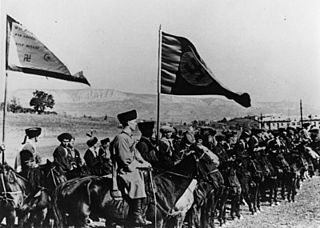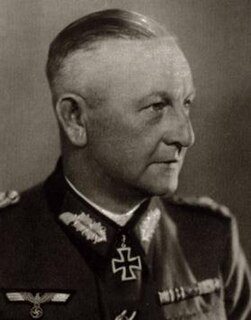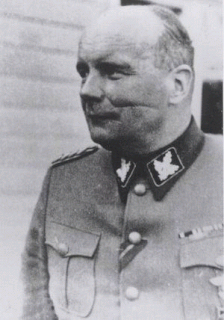
The Waffen-SS was the military branch of the Nazi Party's SS organisation. Its formations included men from Nazi Germany, along with volunteers and conscripts from both occupied and unoccupied lands.
The Waffen Grenadier Brigade of the SS Charlemagne was a unit of the Waffen-SS formed in September 1944 from French collaborationists many of whom were already serving in various other German units. Named after the 9th-century Frankish king, it superseded the existing Legion of French Volunteers Against Bolshevism formed in 1941 within the German Army (Wehrmacht) and the SS-Volunteer Sturmbrigade France formed in July 1943, both of which were disbanded the same month. It also drafted in French recruits from other German military and paramilitary formations and Miliciens who had fled ahead of the Allied Liberation of France.

The 11th SS Volunteer Panzergrenadier Division Nordland was a Waffen-SS division recruited from foreign volunteers and conscripts. It saw action, as part of Army Group North, in the Independent State of Croatia and on the Eastern Front during World War II.

The 3rd SS Panzer Division "Totenkopf" was one of 38 divisions of the Waffen-SS of Nazi Germany during World War II. Its name, Totenkopf, is German for "death's head" – the skull and crossbones symbol – and it is thus sometimes referred to as the Death's Head Division.

The 4th SS Polizei Panzergrenadier Division was one of the thirty-eight divisions fielded as part of the Waffen-SS during World War II.

The 26th Waffen Grenadier Division of the SS , was a short-lived infantry division of the Waffen-SS, an armed branch of the German Nazi Party that served alongside but was never formally part of the Wehrmacht during World War II. Established in November 1944 following the German overthrow of the Hungarian regime of Miklós Horthy, it was never properly formed, trained, or equipped, and after being evacuated from its training camp in the face of the advancing Soviet Red Army, it surrendered to the United States Army in Austria in May 1945.

The 5th SS Panzer Division "Wiking" was a Panzer division among the thirty-eight Waffen-SS divisions of Nazi Germany. It was recruited from foreign volunteers in Denmark, Norway, Sweden, Finland, Estonia, the Netherlands and Belgium under the command of German officers. During the course of World War II, the division served on the Eastern Front. It surrendered in May 1945 to the American forces in Austria.

The 12th Panzer Division was an armoured division in the German Army, the Wehrmacht, during World War II, established in 1940.

The Volunteer Legion Netherlands was a collaborationist military formation recruited in the German-occupied Netherlands during World War II. It was formed in the aftermath of the German invasion of the Soviet Union and fought on the Eastern Front in the Waffen SS alongside similar formations from other parts of German-occupied Western Europe. It was the largest Dutch SS unit.

The 25th Waffen Grenadier Division of the SS "Hunyadi" was a short-lived infantry division of the Waffen-SS, an armed branch of the German Nazi Party that served alongside but was never formally part of the Wehrmacht during World War II. Established in November 1944 following the German overthrow of the Hungarian regime of Miklós Horthy, it consisted mainly of troops drawn from the Royal Hungarian Army's 13th Honvéd Division. It was never properly formed, trained, or equipped, and after being evacuated from its training camp in the face of the advancing Soviet Red Army, it surrendered to the United States Army in Austria in May 1945.

The Siege of Breslau, also known as the Battle of Breslau, was a three-month-long siege of the city of Breslau in Lower Silesia, Germany, lasting to the end of World War II in Europe. From 13 February 1945 to 6 May 1945, German troops in Breslau were besieged by the Soviet forces which encircled the city as part of the Lower Silesian Offensive Operation. The German garrison's surrender on 6 May was followed by the surrender of all German forces two days after the battle.

The XV SS Cossack Cavalry Corps was a cavalry corps in the armed forces of Nazi Germany during World War II.

Hermann Niehoff was a German general during World War II. Since 2 March 1945, he was the garrison commander of Fortress Breslau during the Battle of Breslau, which he surrendered to the Soviet 6th Army on 6 May 1945.

The 28th Jäger Division was a German military unit during World War II.

Otto Kumm was a German divisional commander in the Waffen-SS during World War II and a recipient of the Knight's Cross of the Iron Cross with Oak Leaves and Swords. After the war, he became one of the founders of HIAG, a lobby group and a revisionist organization of former Waffen-SS members.

The 24 cm houfnice vz.39 was a Czechoslovak-designed siege howitzer used in the Second World War. It was kept in production after the German occupation of Czechoslovakia in March 1939 and eighteen were delivered to the Germans. It was only used by the Army's Artillery Regiment 814 and entered service shortly before the Battle of France in 1940. The regiment participated Operation Barbarossa and in the Sieges of Sevastopol and Leningrad.

Carl Friedrich von Pückler-Burghauss was a German politician and a SS functionary during the Nazi era. He was a member of the German parliament during the Weimar Republic. During World War II, Pückler-Burghauss was chief of the Waffen-SS units in the Protectorate of Bohemia and Moravia and also temporarily commanded the Latvian Division of the Waffen-SS.

Max Simon was a German SS commander and war criminal during World War II. Simon was one of the first members of the SS in the early 1930s. He rose through the ranks of the SS, and became a corps commander during World War II. After the war, Simon was convicted for his role in the Marzabotto massacre.
The 6th SS Police Regiment was initially named the 6th Police Regiment when it was formed in 1942 from existing Order Police (Ordnungspolizei) units for security duties on the Eastern Front. It was redesignated as an SS unit in early 1943.

The XXVI Army Corps was a Wehrmacht army corps during World War II. It existed from 1939 to 1945. It was also known as Corps Wodrig during the Invasion of Poland.

















